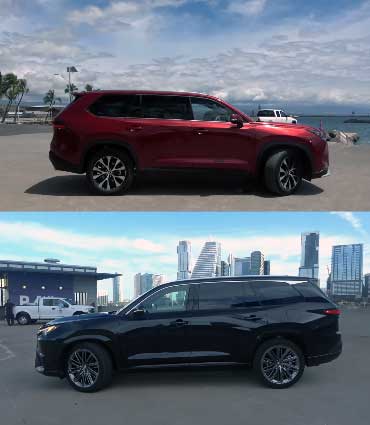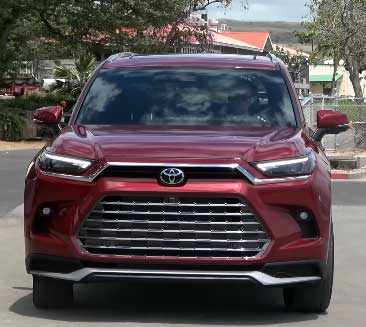As a car enthusiast with a passion for family-friendly SUVs, I set out to explore two standout three-row contenders: the Lexus TX and the Toyota Grand Highlander. My goal is to share a first-hand perspective on how these vehicles stack up. I will focus on their performance, luxury, practicality, and value. By comparing their strengths and weaknesses, I aim to help you decide which SUV best fits your lifestyle. This applies whether you prioritize premium comfort or budget-friendly versatility. Join me as I break down their features to guide your next purchase.

Comparison Table of Lexus TX vs. Toyota Grand Highlander
| Feature | Lexus TX | Toyota Grand Highlander |
|---|---|---|
| Base Price | $55,050 | $43,320 |
| Seating Capacity | 6 or 7 (captain’s chairs or bench) | 7 or 8 (bench or captain’s chairs) |
| Base Engine | 2.4L Turbo I4, 275 hp | 2.4L Turbo I4, 265 hp |
| Hybrid Option | 366 hp (TX 500h), 404 hp (TX 550h+) | 245 hp (Hybrid), 362 hp (Hybrid Max) |
| Fuel Economy | 22 mpg (TX 350), 28 mpg (TX 500h) | 24 mpg (gas), 36 mpg (Hybrid) |
| Cargo Space | 20.2 cu.ft. (behind 3rd row), 97 cu.ft. (max) | 20.6 cu.ft. (behind 3rd row), 97 cu.ft. (max) |
| Infotainment | 14-inch touchscreen, Lexus Interface | 12.3-inch touchscreen, Toyota Multimedia |
| Audio System | 12-speaker (std), 21-speaker Mark Levinson (opt) | 6-speaker (std), 11-speaker JBL (opt) |
| Safety Suite | Lexus Safety System+ 3.0 | Toyota Safety Sense 3.0 |
| Warranty | 6 yrs/70,000 miles (powertrain) | 5 yrs/60,000 miles (powertrain) |
My Journey with Three-Row SUVs
I’ve always been drawn to three-row SUVs for their ability to balance family practicality with road-trip-ready comfort. Over the years, I’ve driven everything from rugged off-roaders to plush luxury models, and the midsize SUV segment has exploded with options. The Lexus TX and Toyota Grand Highlander caught my attention because they share the same GA-K platform, yet cater to different drivers.
The TX promises a premium experience, while the Grand Highlander aims for value and versatility. My time behind the wheel of both revealed distinct personalities. I’m excited to share what I found to help you choose.
Exterior Design and First Impressions

When I first saw the Lexus TX, its sleek, angular grille and sharp LED headlights screamed sophistication. It’s 203.1 inches long, slightly longer than the Grand Highlander’s 201.4 inches. Its 20- or 22-inch wheels add a bold stance.
The TX’s design feels like a refined cousin of the Lexus RX, with a modern, upscale vibe that turns heads.
I noticed its taillight bar and subtle chrome accents give it a premium edge. This makes it perfect for those who want to stand out at the school pickup line.
The Toyota Grand Highlander, on the other hand, has a more rugged, blocky aesthetic. It is reminiscent of the Toyota 4Runner. Its trapezoidal grille and narrower headlights give it a tougher, more utilitarian look. While it’s slightly shorter, it shares the same 116.1-inch wheelbase as the TX, making them feel similar in size.
I found the Grand Highlander’s design practical and approachable. This makes it ideal for families who prioritize function over flash. Its 18- or 20-inch wheels are more modest but still stylish.
Pros of Lexus TX Exterior
- Elegant, luxury-focused design with a bold grille.
- Larger wheel options (up to 22 inches) for a premium look.
- Distinctive taillight bar enhances modern appeal.
Cons of Lexus TX Exterior
- Longer length can make parking trickier in tight spaces.
- Flashy styling might not appeal to understated tastes.
Pros of Toyota Grand Highlander Exterior
- Rugged, family-friendly design with broad appeal.
- Slightly shorter length aids maneuverability.
- Conservative styling blends in easily.
Cons of Toyota Grand Highlander Exterior
- Less distinctive compared to luxury competitors.
- Smaller wheel options feel less premium.
Interior Comfort and Materials
Stepping into the Lexus TX felt like entering a high-end lounge. The cabin is wrapped in premium materials like NuLuxe faux leather (or semi-aniline leather in higher trims), with soft-touch surfaces everywhere. I was impressed by the heated and ventilated front seats, standard across all trims. The available 21-speaker Mark Levinson audio system made my playlists sound concert-worthy.
The second-row captain’s chairs in the six- or seven-seat configurations offered ample comfort. The third row had a surprising 33.5 inches of legroom—enough for adults on shorter trips.
The Toyota Grand Highlander’s interior, while well-built, leans more functional. Its SofTex synthetic leather feels durable but less plush than the TX’s NuLuxe. I liked the spacious cabin, especially the eight-seat option with a second-row bench, perfect for larger families.
The Grand Highlander’s third row matches the TX’s legroom. However, its materials, like Ultrasuede in higher trims, don’t quite match the Lexus’s refinement. The standard six-speaker audio system was decent, but the optional 11-speaker JBL couldn’t rival the TX’s Mark Levinson.
Pros of Lexus TX Interior
- Luxurious materials like semi-aniline leather and ambient lighting.
- Standard heated/ventilated seats enhance comfort.
- Premium audio options elevate the experience.
Cons of Lexus TX Interior
- Six- or seven-seat limit may not suit larger families.
- Power-folding third row is slower than manual options.
Pros of Toyota Grand Highlander Interior
- Eight-seat option for bigger families.
- Durable materials suited for heavy use.
- Practical layout with ample storage cubbies.
Cons of Toyota Grand Highlander Interior
- Less luxurious materials compared to the TX.
- Base audio system feels underwhelming.
Performance and Powertrains

I took both SUVs for a spin to test their performance, and the Lexus TX immediately stood out for its power. The base TX 350’s 2.4-liter turbocharged four-cylinder delivers 275 horsepower, slightly more than the Grand Highlander’s 265 horsepower from the same engine.
The TX 500h hybrid, with 366 horsepower, felt punchy for passing on highways. The TX 550h+ plug-in hybrid (PHEV) blew me away with 404 horsepower and 33 miles of electric range.
The TX’s adaptive suspension and rear-wheel steering, especially in the F Sport Performance trim, made it handle corners with surprising agility for a three-row SUV.
The Grand Highlander’s base 2.4-liter turbo engine was solid but less refined. Its 245-horsepower hybrid option prioritized efficiency, hitting 36 mpg combined, which impressed me for a vehicle this size. The Hybrid Max, with 362 horsepower, matched the TX 500h’s zest but lacked the same polish.
I noticed the Grand Highlander’s steering felt lighter. This was fine for city driving but less engaging on winding roads. Both SUVs tow up to 5,000 pounds, but the TX’s premium tuning gave it a slight edge.
Pros of Lexus TX Performance
- More powerful base engine (275 hp vs. 265 hp).
- Potent PHEV option with 404 hp and electric range.
- Adaptive suspension and rear-wheel steering enhance handling.
Cons of Lexus TX Performance
- TX 350’s 22 mpg combined is less efficient than Grand Highlander’s hybrid.
- PHEV’s eCVT can feel noisy in traffic.
Pros of Toyota Grand Highlander Performance
- Excellent 36 mpg in base hybrid trim.
- Hybrid Max offers strong 362 hp for the price.
- Reliable towing capacity for family adventures.
Cons of Toyota Grand Highlander Performance
- Base engine feels less refined than TX’s.
- Lighter steering lacks sporty feedback.
Technology and Infotainment
The Lexus TX’s tech suite left me impressed. Its 14-inch touchscreen, part of the Lexus Interface system, was crisp and responsive. It features wireless Apple CarPlay and Android Auto integration. I found the voice-activated Intelligent Assistant handy for hands-free commands. However, the wireless Android Auto occasionally dropped during my test drive.
The 12.3-inch digital gauge cluster felt futuristic. Features like Traffic Jam Assist and a Digital Rearview Mirror added a high-tech edge. The standard 12-speaker audio was great, but the 21-speaker Mark Levinson upgrade was a game-changer for audiophiles like me.

The Grand Highlander’s 12.3-inch touchscreen, running Toyota’s Multimedia system, was user-friendly but less polished. It also supports wireless Apple CarPlay and Android Auto.
However, the smaller 7-inch driver display felt dated compared to the TX’s. The standard six-speaker audio was adequate, but the optional 11-speaker JBL system didn’t match the TX’s premium sound.
The Grand Highlander’s Toyota Safety Sense 3.0 suite, while comprehensive, lacks some of the TX’s advanced features like semi-autonomous driving aids.
Pros of Lexus TX Technology
- Larger 14-inch touchscreen with intuitive interface.
- Advanced driver aids like Traffic Jam Assist.
- Superior audio options with Mark Levinson system.
Cons of Lexus TX Technology
- Wireless Android Auto can be finicky.
- Higher trims needed for premium tech features.
Pros of Toyota Grand Highlander Technology
- User-friendly 12.3-inch touchscreen.
- Standard wireless smartphone integration.
- Reliable safety suite with Toyota Safety Sense 3.0.
Cons of Toyota Grand Highlander Technology
- Smaller driver display feels less modern.
- Base audio system lacks punch.
Safety and Driver Assistance
Safety is a priority for family SUVs, and both vehicles deliver. The Lexus TX comes with Lexus Safety System+ 3.0. This includes Lane Tracing Assist, Dynamic Radar Cruise Control, and Pre-Collision System with Pedestrian Detection. I was particularly impressed by extras like Curve Speed Management and Intersection Support, which made city driving feel more secure.
The TX’s oversensitive parking sensors, though, could be annoying in tight lots, beeping far from obstacles.
The Grand Highlander’s Toyota Safety Sense 3.0 offers similar features. These include Lane Departure Warning and Automatic High Beams. However, it misses the TX’s advanced tweaks. Both SUVs felt safe, but the TX’s additional tech gave me more confidence in tricky situations. During my drives, neither vehicle had any major issues, though the TX’s quieter cabin made alerts less intrusive.
Discover More: Xpel Ceramic Coating
Pros of Lexus TX Safety
- Advanced Lexus Safety System+ 3.0 with extra features.
- Quiet cabin enhances alert clarity.
- Digital Rearview Mirror improves visibility.
Cons of Lexus TX Safety
- Overly sensitive parking sensors can be frustrating.
- Advanced features limited to higher trims.
Pros of Toyota Grand Highlander Safety
- Comprehensive Toyota Safety Sense 3.0 suite.
- Reliable safety features across all trims.
- Strong crash-test ratings expected.
Cons of Toyota Grand Highlander Safety
- Lacks some of TX’s advanced driver aids.
- Noisy alerts in a less insulated cabin.
Cargo and Practicality
Both SUVs are built for family hauling, but their approaches differ. The Lexus TX offers 20.2 cubic feet behind the third row. This expands to 97 cubic feet with all seats folded. I loved the flat load floor, perfect for bulky gear. The spring-assisted second row made third-row access a breeze, though the power-folding third row was slower than I’d like. The TX’s focus on luxury means it prioritizes comfort over max seating, capping at seven passengers.
The Grand Highlander edges out slightly with 20.6 cubic feet behind the third row. It matches the 97-cubic-foot max. Its eight-seat option is a boon for larger families. The manual seat adjustments felt quicker. I found the Grand Highlander’s extra cubby in front of the passenger seat handy for small items. This is something the TX lacks.
Consider Essential Maintenance: Wix vs. Microgard Oil Filter
Pros of Lexus TX Cargo
- Flat load floor for easy cargo loading.
- Spring-assisted second row for accessibility.
- Ample max cargo space for family needs.
Cons of Lexus TX Cargo
- Slightly less third-row cargo space than Grand Highlander.
- Power-folding seats are slow.
Pros of Toyota Grand Highlander Cargo
- Extra 0.4 cu.ft. behind third row.
- Eight-seat option for larger families.
- Practical storage solutions throughout.
Cons of Toyota Grand Highlander Cargo
- Manual seat adjustments less premium.
- Cargo space nearly identical to TX.
Pricing and Value
Price is where these SUVs diverge most. The Lexus TX starts at $55,050. This is an $11,730 premium over the Grand Highlander’s $43,320. I found the TX’s base trim well-equipped. Features like a digital gauge cluster and 12 speakers justify some of the cost. The TX 500h ($69,350) and TX 550h+ ($78,560) add performance and efficiency. However, they push the price into luxury territory. The longer 6-year/70,000-mile powertrain warranty also adds peace of mind.
The Grand Highlander’s value shines through. Its base trim is solid. The Hybrid XLE ($45,380) offers 36 mpg at a bargain. Even the top-tier Hybrid Max Platinum ($58,775) undercuts the TX 500h. The 5-year/60,000-mile warranty is shorter, but Toyota’s reliability reputation is reassuring. For budget-conscious buyers, the Grand Highlander delivers nearly all the TX’s practicality at a lower cost.
Pros of Lexus TX Pricing
- Well-equipped base trim with premium features.
- Longer warranty for added security.
- High-end trims offer unique PHEV option.
Cons of Lexus TX Pricing
- Significant price premium over Grand Highlander.
- Higher trims approach full-size luxury SUV costs.
Pros of Toyota Grand Highlander Pricing
- Lower starting price and better value.
- Affordable hybrid options with great efficiency.
- Reliable brand with lower maintenance costs.
Cons of Toyota Grand Highlander Pricing
- Shorter warranty than Lexus.
- Fewer premium features in base trims.
Driving Experience and Ride Quality
Driving the Lexus TX felt like gliding in a luxury cocoon. Its extra sound-deadening materials made the cabin whisper-quiet, even at highway speeds. The TX 500h F Sport Performance’s adaptive dampers and rear-wheel steering gave it a sporty edge, minimizing body roll in corners. However, the TX 550h+’s eCVT occasionally droned in traffic, which slightly marred the experience.
The Grand Highlander was surprisingly quiet for a Toyota, though not as hushed as the TX. Its ride was comfortable but less refined. It has a lighter steering feel that suited city commutes but felt disconnected on backroads. The Hybrid Max’s power was thrilling, but the TX’s polish won me over for long drives.
Pros of Lexus TX Ride Quality
- Quieter cabin with superior sound insulation.
- Sporty handling in F Sport Performance trim.
- Smooth ride for long-distance comfort.
Cons of Lexus TX Ride Quality
- eCVT drone in PHEV model can be noticeable.
- Less agile in base trim.
Pros of Toyota Grand Highlander Ride Quality
- Comfortable ride for family use.
- Hybrid Max offers strong acceleration.
- Handles well for its size.
Cons of Toyota Grand Highlander Ride Quality
- Less refined than TX’s ride.
- Steering lacks engagement.
Who Should Choose Which SUV?
After driving both, I see the Lexus TX as the choice for those craving luxury. Its refined interior, advanced tech, and potent powertrains make it ideal if you want a premium experience and don’t mind the price. The TX 550h+’s plug-in hybrid is a unique draw for eco-conscious buyers who still want power.
The Toyota Grand Highlander is the practical pick. Its lower price, eight-seat option, and efficient hybrid make it perfect for budget-focused families who need space and reliability without the luxury badge. If value and versatility are your priorities, the Grand Highlander delivers.
Frequently Asked Questions
No, they share the same GA-K platform but differ in luxury, features, and performance. The TX is more premium, while the Grand Highlander focuses on value
The Lexus TX is the closest equivalent, sharing the same platform and size but with upscale materials and advanced tech
Yes, the Lexus GX is larger, with a body-on-frame design (120.9-inch wheelbase vs. 116.1 inches), but it’s more off-road-focused than family-oriented.
Conclusion
I’ve spent time behind the wheel of both the Lexus TX and Toyota Grand Highlander, and I’m confident you’ll find a great fit in one of these SUVs. The TX offers a luxurious, tech-packed ride for those who value refinement, while the Grand Highlander brings unbeatable value and practicality. Consider your budget and priorities—luxury or affordability—and test drive both to feel the difference. Whichever you choose, you’re getting a capable three-row SUV that’s ready for your family’s adventures.

